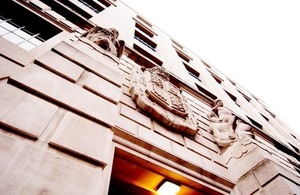Google Earth zooms in on dangerous climate change
A new interactive Google Earth map showing the impacts of a 4°C world was launched today by the government. Pushing the barriers with Google…

A new interactive Google Earth map showing the impacts of a 4°C world was launched today by the government.
Pushing the barriers with Google Earth technology, the multi platform, interactive map highlights some of the changes that may occur if the global average temperature rises by 4°C above the pre-industrial climate average.
The Google Earth layer lends a human face to climate science by featuring videos of climate scientists from the UK explaining the latest scientific research behind the climate impacts shown.
The map also includes videos of FCO and British Council climate change projects currently taking place around the world.
Launched by Foreign Office Minister Henry Bellingham and Climate Change Minister Greg Barker alongside Chief Government Scientist, Professor John Beddington, the map was developed using peer-reviewed science from the Met Office Hadley Centre and other leading impact scientists.
The UK government is committed to keeping global temperatures as low as practical to avoid dangerous levels of climate change and is working to secure an ambitious global deal which achieves this. The Copenhagen Accord already commits countries to limiting average global temperature increases to 2°C.
Foreign Office Minister, Henry Bellingham, said:
The threat from climate change has not gone away and this Government is committed to doing what it can to take action. We are committed to being the ‘greenest’ Government ever. As the Foreign Secretary set out recently in his first major foreign policy speech, he is keen to engage with new audiences. This Google Earth map supports that commitment to tackling climate change and will hopefully communicate with a bigger audience globally about why the UK Government is being active in championing the transition to a low carbon economy.
Greg Barker, Energy and Climate Change Minister said:
This map reinforces our determination to act against dangerous man-made climate change. We know the stakes are high and that’s why we want to help secure an ambitious global climate change deal
Ed Parsons from Google said:
This is a great example of the benefits of using the latest web technology to visualise scientific information and promote better understanding of the potential human impacts of climate change. Allowing scientists to talk about their research to the general public is a way to enable the public to fully understand how the process of scientific investigation works.
Vicky Pope from the Met Office said:
If greenhouse gas emissions continue to rise, global average temperatures could increase by 4°C by the end of the century, and possibly as early as 2060. This new mapping onto Google Earth illustrates some of the potential impacts of such a rise. It uses the latest climate and impacts science to highlight the consequences of not reducing emissions.
Notes to editors
- The online Google Earth map is available at: http://www.fco.gov.uk/google-earth-4degrees.kml
- Please note that you will require Google Earth to be installed - http://earth.google.co.uk/
- Further information on the science can be found at http://www.fco.gov.uk/4degrees
Background to the +4 degree C temperature rise impact Google Earth Map
This Google Earth Map highlights some of the human impacts that may occur if the global average-temperature rises by 4 degree C above the pre-industrial climate average.
Map projection
The map projection was generated using Met Office Hadley Centre’s HadCM3 QUMP ensemble model runs, for the A1B and A1FI Scenarios for all the models that showed a global average temperature rise of +4 degree C before the end of the century. There were 23 runs in total, and these were averaged at the point they each reached a +4 degree C rise. This projection does not therefore represent a particular point in time, as each model reached +4 degree C at a different time.
Things to note include the higher temperatures over land compared to the sea, and the extreme temperatures increases in the Arctic.
Impacts
The impacts featured in this Google Earth Map are not an exhaustive list. A selection of impacts was chosen to cover the major headline themes, (water, food, etc.), but not every impact across the globe is covered. The selection of the results was also chosen to reflect some of the research that is going on across the UK since Intergovernmental Panel on Climate Change, and work that has looked in particular at what high-end climate change would mean.
The Google Earth Map focuses on human impacts. Impacts on ecosystems and biodiversity have been deliberately excluded. The only exception is the information about Amazon die-back, which is there because it also represents a significant economic loss to the region.
Contacts
For more information please contact FCO Press Office on 0207 008 3100.